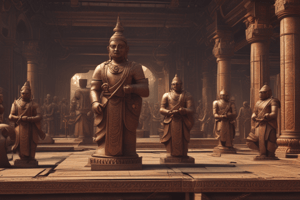Podcast
Questions and Answers
What ancient Indian text describes the production of salt from sea?
What ancient Indian text describes the production of salt from sea?
Kautilya’s Arthashastra
Which ancient Indian work mentions the preparation of sulphuric acid, nitric acid, and various metal oxides and carbonates?
Which ancient Indian work mentions the preparation of sulphuric acid, nitric acid, and various metal oxides and carbonates?
Charaka Samhita
Who was the Indian scientist known for his work in chemistry, alchemy, and metallurgy?
Who was the Indian scientist known for his work in chemistry, alchemy, and metallurgy?
Nagarjuna
What did the Rasopanishada describe the preparation of?
What did the Rasopanishada describe the preparation of?
According to Sushruta Samhita, what was emphasized as important?
According to Sushruta Samhita, what was emphasized as important?
Which book, appearing around 800 CE, deals with the formulation of mercury compounds?
Which book, appearing around 800 CE, deals with the formulation of mercury compounds?
What is the name of the governmental treaty organization created by a diplomatic treaty known as Metre Convention?
What is the name of the governmental treaty organization created by a diplomatic treaty known as Metre Convention?
Which laboratory in New Delhi is responsible for establishing experiments to realize base units and derived units of measurement in India?
Which laboratory in New Delhi is responsible for establishing experiments to realize base units and derived units of measurement in India?
In which year was the establishment of a common standard system discussed and agreed upon by the scientific community?
In which year was the establishment of a common standard system discussed and agreed upon by the scientific community?
What was the purpose of the Metre Treaty signed in 1875 by member nations?
What was the purpose of the Metre Treaty signed in 1875 by member nations?
What is the responsibility of National Metrology Institutes (NMIs) in modern industrialized countries like India?
What is the responsibility of National Metrology Institutes (NMIs) in modern industrialized countries like India?
Which country originated the metric system in the late eighteenth century?
Which country originated the metric system in the late eighteenth century?
What is the molecular formula of ethanol?
What is the molecular formula of ethanol?
What is the mass percentage of carbon in ethanol?
What is the mass percentage of carbon in ethanol?
In a 100g sample of the compound, how much chlorine is present?
In a 100g sample of the compound, how much chlorine is present?
What is the ratio of hydrogen to carbon to chlorine in the compound?
What is the ratio of hydrogen to carbon to chlorine in the compound?
How many moles of carbon are present in the compound?
How many moles of carbon are present in the compound?
What is the molar mass of ethanol?
What is the molar mass of ethanol?
How is uncertainty in an experimental or calculated value indicated?
How is uncertainty in an experimental or calculated value indicated?
In the measurement 11.2 mL, which digit is certain and which one is uncertain?
In the measurement 11.2 mL, which digit is certain and which one is uncertain?
According to the rules for determining significant figures, are zeros preceding the first non-zero digit significant?
According to the rules for determining significant figures, are zeros preceding the first non-zero digit significant?
How many significant figures are in the measurement 0.0052 mL?
How many significant figures are in the measurement 0.0052 mL?
Are zeros at the end or right of a number significant?
Are zeros at the end or right of a number significant?
How many significant figures are in the measurement 2.005 cm?
How many significant figures are in the measurement 2.005 cm?
What is the molarity of the solution given that the mass of NaCl in 1 L solution is 175.5 g?
What is the molarity of the solution given that the mass of NaCl in 1 L solution is 175.5 g?
What is the mass of water in the solution if the total mass of the 1 L solution is 1250 g?
What is the mass of water in the solution if the total mass of the 1 L solution is 1250 g?
Define molality and provide the formula to calculate it.
Define molality and provide the formula to calculate it.
What is the molality of the solution if it contains 3 moles of solute in 1.0745 kg of solvent?
What is the molality of the solution if it contains 3 moles of solute in 1.0745 kg of solvent?
What is a stock solution and how is it used in preparing solutions of desired concentrations?
What is a stock solution and how is it used in preparing solutions of desired concentrations?
Why does the molality of a solution not change with temperature?
Why does the molality of a solution not change with temperature?
Flashcards are hidden until you start studying




